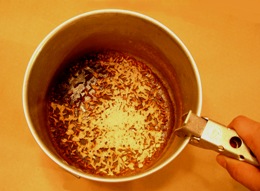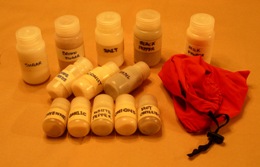| Food Repair |
Over-cooked & Charred
I remembered I had over-cooked my rice and charred the pot so many times when I was
young. This is like the classics of all time. Everyone has to admit they had done
this at least once.
The first thing is to avoid using pots with charred bottom inside. It will only make
things worse. Spend the time to scrub it before you start cooking. It will payoff
at the end.
The key to prevent over-cooking is to turn down your stove. Most of the time the reason
of charring the pot is impatience. "We are so hungry, let's turn up the heat so that it
will cook faster."
Nah! Food ingredients need time to absorb water and will only be cooked in certain temperature.
Turning up the heat will only reduce the time to take the water to boil, but does not necessarily
make the ingredients cook faster.
As I mentioned in the Helpful Hints section of the
Food Planning & Package page, pasta or grains with short cooking times should ONLY be
put into boiling water and perhaps stir it once in a while. Else, pasta will over-soak,
stick to the bottom and then char, and a whole lot of scrubing afterwards.
But what else can I do if I over-cooked / charred the pasta ? As soon as you smell the charring,
turn down the heat. The key is NOT to stir and scrape the bottom, which all the charred pasta
and rice are deposited. You can still salvage the top portion for an edible meal.
|

|
Avoid stiring or scraping the bottom.
You can still eat the top portion.
The next thing after salvaging is to soak & scrub
the pot, else god bless the next meal.
|
|
Rice (rice-to-water ratio should be 1:1)
Rice cooks in a much higher temperature. Once it boils, turn DOWN the
stove. Check your rice regularly. And as soon as you see some holes in the rice, turn OFF
the stove, and put the lid back on the pot. Rice will continue to cook itself. Let the rice
sit about 10 minutes and it will be ready to serve.
Another way to cook rice is to use a lot of water. Pick a few from the boiling pot to see if
the rice is ready. If so, drain the water to another pot. You can reuse those excess water for
soup later.
|
|
|
| |
Spice Kit (Food Repair Kit)
Another common way to fix our
"not-so-good" cooking in the backcountry is to use spices.
Bring a spice kit (sometimes I called it the "Food Repair Kit") with you. Let everyone
add the extra taste to their own food.
I assembled mine by using a few small (60ml) nalgene bottles. I simply took some herbs and
spices, salt and pepper from my kitchen and it is done. And if you are lazy, just stop by
McDonald's and get some. I am sure you've done it before!
|

|
I don't bring my entire spice kit every time.
Bring it only if you have room and weight to spare.
|
|
You don't have to bring your spice kit every trip. Consider to pre-mix your ingredients with
some spices beforehand. This may save you some room and weight in your backpack.
My spice kit includes the following:
- Salt
- Black Pepper
- White Pepper
- Sugar
- Brown Sugar
- Milk Powder (for making tea)
- Seasame Seeds (smell tasty)
- Coconut (serve with rice)
- Basil (for soups or tuna)
- Cayene Pepper (hot & spicy)
- Garlic Powder
- Onion Flakes
- Hot Chilli Flakes (extra hot)
|
|